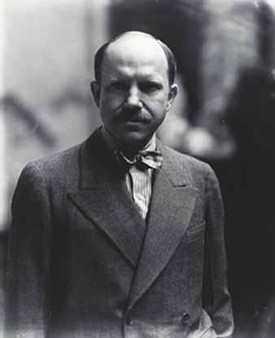Group of Bears
Introduction
Text-to-speech Audio
Images
Group of Bears

Paul Manship (1885-1966)

The Paul J. Rainey Memorial Gateway at the Bronx Zoo

The 1939 miniature of the group donated by Manship to the Smithsonian American Art Museum in Washington, D.C., where it remains today

Backstory and Context
Text-to-speech Audio
In 1926, renowned art collector and philanthropist Grace Rainey Rogers commissioned artist Paul Manship to design a gateway for the main entrance of the New York Zoological Park (now the Bronx Zoo) in honor of her late brother, businessman and avid hunter, Paul J. Rainey. Installed in 1934, the Paul J. Rainey Memorial Gateway measures forty-two feet wide and over thirty-four feet tall. Made of bronze, it features two gates flanked by three stylized trees filled with many different species of animals and birds. Two large lunettes sit atop the gates, one containing three deer and the other, three bears. One bear is standing on its back legs, another is sitting, and the third is walking.
A few years before the gateway’s installation, Manship constructed a life-sized plaster model of the three bears. He maintained their original poses (one standing on its back legs, another sitting, and the third walking), but rearranged them to all face in the same direction. Additionally, Manship placed them on stylized rocks embellished with a branch of ivy. Decades later, in 1963, a bronze cast of the piece was created in Milan, Italy. For two and a half decades, the sculpture rested outdoors on the grounds of Manship’s home in Lanesville, Massachusetts, near Gloucester. In 1987, Manship’s son, John, sold the sculpture to an art gallery in New York City. Sometime later, Richard and Sheila Schwartz purchased it and subsequently donated it to the Metropolitan Museum of Art.
Throughout the remainder of his career, Manship produced different versions of the sculpture. Additionally, he incorporated some of the bears in his designs for new projects. In 1939, Manship created a thirty-three-inch miniature version of the group. He integrated the piece into his overall design for the William Church Osborn Memorial Playground Gateway in Central Park. A few years before his death in 1966, Manship donated the original miniature to the Smithsonian American Art Museum in Washington, D.C., where it remains today. In 1934, he recast two of the life-sized bears (the standing bear and the walking bear) and placed them on individual pedestals for what is now the Cheyenne Mountain Zoo in Colorado Springs, Colorado.
In 1989, Samuel N. Friedman commissioned a cast of Manship’s piece in honor of his late wife, Pat Hoffman Friedman. Produced at Paul King Foundry in Johnston, Rhode Island, the sculpture was unveiled the following year at the dedication of Central Park’s Pat Hoffman Friedman Memorial Playground, near the Metropolitan Museum of Art. Since then, much like the statue of the sled-dog Balto (also located in Central Park), the bronze sculpture has been a favorite of children, who enjoy interacting with the piece by touching and climbing it.
Aside from being a prolific sculptor of animals, Manship also created numerous pieces depicting famous figures of ancient mythology. His most well-known work, arguably, is Prometheus. Installed in Manhattan’s Rockefeller Center in 1934, the gilded bronze sculpture of the Titan of Greek mythology who gave humankind the gift of fire is one of the most popular public artworks in New York City.
Sources
"Group of Bears." Central Park Conservancy. Web. 15 January 2021 <https://www.centralparknyc.org/locations/group-of-bears>.
"Group of Bears." New York City Department of Parks and Recreation. The City of New York. Web. 15 January 2021 <https://www.nycgovparks.org/parks/central-park/monuments/646>.
"Group of Bears." Smithsonian American Art Museum. Web. 15 January 2021 <https://americanart.si.edu/artwork/group-bears-15831>.
Tolles, Thayer, ed. American Sculpture in the Metropolitan Museum of Art. Vol. II, A Catalogue of Works by Artists Born between 1865 and 1885. New York: The Metropolitan Museum of Art, 2001.
https://en.wikipedia.org/wiki/Group_of_Bears
https://americanart.si.edu/artist/paul-manship-3096
https://www.loc.gov/item/2011632011/
https://americanart.si.edu/artwork/group-bears-15831
